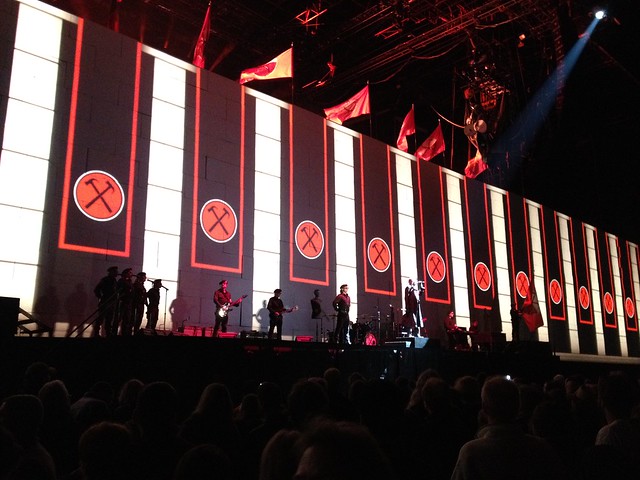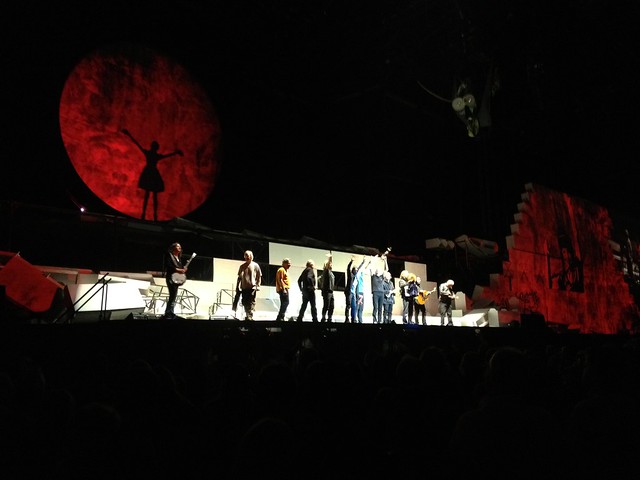
In 1979, a record that would forever shape the concept of what an “album” was, or could be, was released. Its chief creator, one Roger Waters (of the English rock juggernaut Pink Floyd), brainstormed a show so daunting, so massive, and so strange in scope, that in its heyday it was nigh impossible to tour with. Thus, the original 1980 tour of The Wall made roughly 30 appearances, over only four cities, for in accordance with the themes of isolation and seclusion that dominated this record, its corresponding live rendition involved the construction of a massive wall that separated the band from the audience. Three decades after the original Wall tour, live concert production capabilities have increased dramatically, and arena- and stadium-based shows have taken on an even grander scale than ever before seen. Thus, in 2012, Waters’ original dream finally has come to fruition. The Wall Live is absolutely that: the iconic album of 1979 finally brought to life, in the way and at the scale that it had originally been intended to be witnessed.

2012 is the third year that Waters has been touring his new-millenium Wall Live production, and after two stops in Oakland and San Jose back in 2010, the colossal show returned to the Bay Area and took up residence in San Francisco’s own Giants stadium, today known as AT&T Park. Anyone shocked by the size of the lines of people that wrapped around the stadium from end to end, even hours before the show began, would be further stunned when they finally entered the stadium and witnessed the gigantic wall that was the production’s namesake. Boasting the largest projection surface in live entertainment today, the Wall is constructed of 1,000 individual bricks that are added over the course of the evening to create a 500-foot-long, 40-foot-tall screen. In its center, and visible for most of the first half of the album, stands Roger Waters and his backing band, composed chiefly of Dave Kilminster and Snowy White (guitars), Jon Carin and Harry Waters (keyboards), and Graham Broad (drums), with Waters taking up primary duties on bass guitar.

Just after 8:30pm, the lights in the stadium fell as an ominous voice announced “Ladies and gentlemen… welcome to the war”, and a pair of black-leather-clad soldiers marked to the center of the stage, carrying an effigy of the character of Pink Floyd between them (as presented at the end of the album, and in the movie Pink Floyd The Wall). The sentence and decree of the Judge was bellowed out over the crowd, and without warning, the stage exploded with light and sound, as a volley of fireworks and smoke were launched into the air, bathing the stage and its occupants in a stark red glow, as the first howling notes of “In The Flesh?” roared out of the loudspeakers. Moments later, Waters himself marched onto the stage, and walked from side to side to greet his crowd, his fists raised in triumph as he crossed from end to end of the already-massive area that was NOT yet covered by the Wall. Waters took up the proffered leather coat and sunglasses that sat at the front and center of the stage, and belted out the words of the opening number — and thus, the show had begun.

For the first few songs of the set, the Wall slowly came alive with images of deceased soldiers from times of war, while Waters and his band played on under the stark reddish glow onstage. During “Another Brick In The Wall” and “Mother”, staggeringly-tall marionette puppets, in the form of the Schoolteacher and the Mother respectively, descended slowly from the rafters high above, creeping slowly towards the musicians as the songs filled the stadium around them. In accordance with the singing children on the former song, a chorus of kids rushed out for the second half of “Another Brick In The Wall, Pt. 2”, gesticulating and pointing furiously at the Schoolteacher as it arched over them like a tall wraith from the depths of Hell itself. All the while, crews of black-clad stagehands built the Wall up in front of the band, one piece at a time, with each brick starting out a dark, pale gray and fading in to become part of the larger projection upon the wall as it was set in place, the incredible feat seamlessly accomplished by 41 projectors that towered over the crowd on the field below.

The projections upon the Wall were an intriguing blend of older footage — most from Pink Floyd The Wall, the psychedelic film released as a visual accompaniment to the album — and newly-created pieces that staunchly showcased a semi-futuristic world of totalitarianism, dominated by religion, corporations, and oppressive authority. The messages of anti-consumerism, rebellion, and the fight against paranoia have all been present on the lyrics of The Wall, but a different, more modern interpretation was foisted upon the crowd in the projected images that danced across the Wall throughout the night — less personal, and more thought-provoking, with a sense of disquiet and even outrage simmering just below the surface. The chilling images of crossed hammers, wielded on stark red armbands and scarlet flags, paraded around like neocon swastikas, help to cement the theme of a world that was dark and worrisome — perhaps, in reality, the perception created by the protagonist of the story.

True to the original vision of the performance, the Wall was fully filled by the time the band finished the penultimate track on the first half of the record, the disruptive, rebellious “Another Brick In The Wall, Pt. 3”, with the final bricks being placed before the rest of the band as the final notes were shouted out. After the words of “Goodbye Cruel World” were quietly sung to the audience, the last brick was slid into place, and the lights went up on the field for the intermission that separated the two halves of the album. “Hey You” and “Is There Anybody Out There” were performed with the band completely invisible from the crowd, and only small sections of the Wall slid away for “Nobody Home” and “Vera”, revealing Waters as he continued the story. Waters finally came before the Wall for “Bring The Boys Back Home” and the epic centerpiece “Comfortably Numb”, and a surrogate band (true to the lyrics of the song that followed) was placed onstage for the second version of “In The Flesh”. The crowd’s attention was pulled away from them, however, with the appearance of a huge, floating pig, a jet-black blimplike thing covered in harsh graffiti and corporate logos, that soared back and forth across the stadium, as the crowd pointed, shrieked, and clawed at it when it came too close.

Such a thrilling show had only one way that it could come to a close: the collapse of the Wall itself. True to the original form and lyrics of the album — chiefly the climax piece “The Trial” — the sentence to “tear down the wall!” could be heard in a glorious chant from end to end of the massive stadium, and as the sound and fury drew to a peak, the Wall suddenly imploded in on itself from the top, the bricks spilling all over the stage under another haze of hellish light. The surrogate band having long since vanished from their places, the real musicians climbed over the rubble before them amid a gale of cheers and screams, and as the howling of the crowd died down, the final song “Outside The Wall” shimmered softly to life. The story had been told, the players waved and took their bows, and the evening had come to a close — and thus, The Wall was over.

In all my years of concertgoing, I have never seen a live production with the scope and scale of The Wall. One feels positively dwarfed before it, as tiny and insignificant as an ant before a rhino, and it is its own living creature, undulating with color and animation, and teeming with life as it grows and concatenates, obscuring its players like a swarm of technicolor locusts bathed in the slogans of anti-war propaganda. It is a tour de force of the senses, loud and obtrusive, fierce and unyielding, and at the same time a gorgeous listening experience. Closing my ears, I could still feel all of the thrill and wonder I had experienced the first time I heard the record from end to end, and the visual accompaniment brought my excitement to unthinkable levels. This is the new gold standard for epic stage productions, and it remains to be seen whether anything will come close to the grandeur of this show.
Additional close-up photos from the show below. All photos in this gallery © 2012 Jonathan Pirro.
For additional photos taken from the crowd, please see gloomboy’s set on Flickr.
For behind-the-scenes photos of the week-long process involved in the creation and takedown of the Wall set, please see Alan Ralph’s photo set on Facebook.
















Perfect. Wouldn’t change a thing. Mr. Pirro, you rock.
“…a different, more modern interpretation was foisted upon the crowd in the projected images that danced across the Wall throughout the night — less personal, and more thought-provoking, with a sense of disquiet and even outrage simmering just below the surface.”
Couldn’t agree more. The problem with the original production of The Wall was its solipsism and narcissistic woe-is-me-ism, and by recontextualizing it to become more of an overt political statement, Waters has made this album far more relevant than it was even in 1979.
Including of “Big MOTHER is watching you,” having the wife character sing in a German accent, bringing in the spectre of Hitler as a failed artist with the “iPaint” faux iPod ad, add the UC-Davis pepper spray cop John Pike and the Wikileaks footage in the projections… all of these choices helped transform “The Wall” from the story of an English schoolboy who loses his dad in WWII to a more universal tale about the fight against fascism in all of its ugly forms, on a societal scale and on a personal level.
Mr. Pirro, you rock.